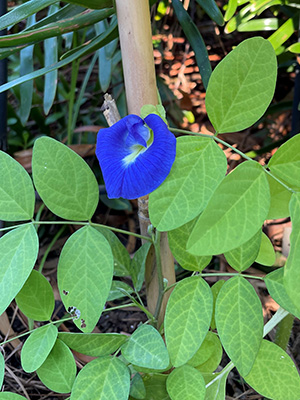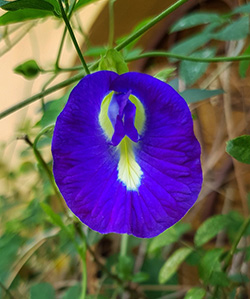Butterfly Pea

Butterfly pea is not named for attracting butterflies, but instead because its brightly colored flowers resemble butterflies. This Asian vine benefits the garden by fixing nitrogen in the soil as other legumes do. Blooms appear year-round, and the flowers can be used to make dye and color-changing tea.
Characteristics
Butterfly pea (Clitoria ternatea) is rapidly growing vine that can reach up to 15 feet long. The leaves and flowers both resemble those of other pea plants. The blooms are a vibrant blue, with a white and yellow center. The flowers lead to seed pods that are two to three inches long. The flowers, leaves, young shoots, and tender pods are all edible, making it an incredibly efficient addition to your foodscape. While it’s the flowers that are more commonly used to make dyes and teas, the leaves can also be used to create a green dye.
The flower contains phenolic pigments, called anthocyanins, that give it the gorgeous hue. The anthocyanins also have antioxidant properties, which means they have health benefits too. The color of a butterfly pea extract changes based on the pH. When the pH is lowered (such as by adding lemon juice) it turns from indigo to pink or pale purple. When the pH is raised (such as by adding saffron), the extract turns green.
Planting and Care
Butterfly pea prefers full sun and soil with good drainage. In the winter, you can start seeds indoors six to eight weeks before the last frost. After the frost has past, seeds can be sown six to eight inches apart directly into the soil. Establish trellises to support your plants as they grow, or plant butterfly pea along a fence.

In Central and South Florida, butterfly pea can be a perennial. You’ll want to treat it like an annual in the northern parts of the state. Save your seeds at the end of each season so you’ll have vibrant butterfly pea vines every year without having to visit a nursery. For more about butterfly pea, contact your county Extension office.
DIY Blue Dye
UF/IFAS researchers recently studied butterfly pea dye-making to discover the best process. Here is our guide.
Step one: choose your solvent. The ideal solvent is alcohol that is 40% ABV (80 proof), but water can be used instead if desired.
Step two: steep the flowers. You’ll use one gram of flowers for every 20 mL of alcohol or water. Measure your solvent and weigh out enough flowers to produce your desired amount of dye. Then, add the flowers and solvent to a pot and heat it to a maximum temperature of 170°F. Heat this mixture for a total of 60 minutes.
Step three: strain the flowers. Once steeping is done, you can strain the flowers. After it is cooled, test out your dye to see if it changes colors with the addition of an acid. If it doesn’t, you can dilute your dye with more alcohol or water until color-changing happens. This recipe produces the most concentrated dye possible, which could be too strong for home use without dilution.
Butterfly Pea Tea
Brewing butterfly pea tea is a simple way to enjoy the flower’s flavor and color-changing properties.
Watch our step-by-step tutorial on making color-changing tea
from butterfly pea flowers
Use one-quarter of a cup of dried butterfly pea flowers per one to two cups of water. Bring the water to a boil, then remove from heat and add your flowers. Allow them to steep until the water has turned a deep purple or indigo, up to eight minutes. It can be served hot or over ice. Then, add lemon juice and sweetener to taste. As you add the lemon juice, watch the color change from purple to pink!
